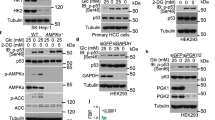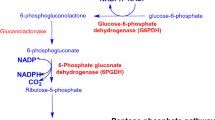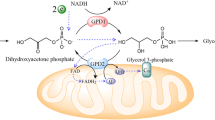Abstract
Aerobic glycolysis, also known as the Warburg effect, is a hallmark of cancer cell glucose metabolism and plays a crucial role in the activation of various types of immune cells. Glyceraldehyde 3-phosphate dehydrogenase (GAPDH) catalyzes the conversion of D-glyceraldehyde 3-phosphate to D-glycerate 1,3-bisphosphate in the 6th critical step in glycolysis. GAPDH exerts metabolic flux control during aerobic glycolysis and therefore is an attractive therapeutic target for cancer and autoimmune diseases. Recently, GAPDH inhibitors were reported to function through common suicide inactivation by covalent binding to the cysteine catalytic residue of GAPDH. Herein, by developing a high-throughput enzymatic screening assay, we discovered that the natural product 1,2,3,4,6-penta-O-galloyl-β-D-glucopyranose (PGG) is an inhibitor of GAPDH with Ki = 0.5 μM. PGG blocks GAPDH activity by a reversible and NAD+ and Pi competitive mechanism, suggesting that it represents a novel class of GAPDH inhibitors. In-depth hydrogen deuterium exchange mass spectrometry (HDX-MS) analysis revealed that PGG binds to a region that disrupts NAD+ and inorganic phosphate binding, resulting in a distal conformational change at the GAPDH tetramer interface. In addition, structural modeling analysis indicated that PGG probably reversibly binds to the center pocket of GAPDH. Moreover, PGG inhibits LPS-stimulated macrophage activation by specific downregulation of GAPDH-dependent glucose consumption and lactate production. In summary, PGG represents a novel class of GAPDH inhibitors that probably reversibly binds to the center pocket of GAPDH. Our study sheds new light on factors for designing a more potent and specific inhibitor of GAPDH for future therapeutic applications.
Similar content being viewed by others
Log in or create a free account to read this content
Gain free access to this article, as well as selected content from this journal and more on nature.com
or
References
Warburg O. The metabolism of carcinoma cells. J Cancer Res. 1925;9:148–63.
Warburg O. On the origin of cancer cells. Science. 1956;123:309–14.
Geltink RIK, Kyle RL, Pearce EL. Unraveling the complex interplay between T cell metabolism and function. Annu Rev Immunol. 2018;36:461–88.
Kelly B, O’Neill LA. Metabolic reprogramming in macrophages and dendritic cells in innate immunity. Cell Res. 2015;25:771–84.
Palsson-McDermott EM, O’Neill LAJ. Targeting immunometabolism as an anti-inflammatory strategy. Cell Res. 2020;30:300–14.
Patel CH, Leone RD, Horton MR, Powell JD. Targeting metabolism to regulate immune responses in autoimmunity and cancer. Nat Rev Drug Discov. 2019;18:669–88.
Seth Nanda C, Venkateswaran SV, Patani N, Yuneva M. Defining a metabolic landscape of tumours: genome meets metabolism. Br J Cancer. 2020;122:136–49.
Martin WF, Cerff R. Physiology, phylogeny, early evolution, and GAPDH. Protoplasma. 2017;254:1823–34.
Murthi P, Fitzpatrick E, Borg AJ, Donath S, Brennecke SP, Kalionis B. GAPDH, 18S rRNA and YWHAZ are suitable endogenous reference genes for relative gene expression studies in placental tissues from human idiopathic fetal growth restriction. Placenta. 2008;29:798–801.
Chauhan AS, Kumar M, Chaudhary S, Patidar A, Dhiman A, Sheokand N, et al. Moonlighting glycolytic protein glyceraldehyde-3-phosphate dehydrogenase (GAPDH): an evolutionarily conserved plasminogen receptor on mammalian cells. FASEB J. 2017;31:2638–48.
Guha P, Harraz MM, Snyder SH. Cocaine elicits autophagic cytotoxicity via a nitric oxide-GAPDH signaling cascade. Proc Natl Acad Sci USA. 2016;113:1417–22.
Chuang DM, Ishitani R. A role for GAPDH in apoptosis and neurodegeneration. Nat Med. 1996;2:609–10.
Waingeh VF, Lowe SL, Thomasson KA. Brownian dynamics of interactions between glyceraldehyde-3-phosphate dehydrogenase (GAPDH) mutants and F-actin. Biopolymers. 2004;73:533–41.
Kosova AA, Khodyreva SN, Lavrik OI. Role of glyceraldehyde-3-phosphate dehydrogenase (GAPDH) in DNA Repair. Biochem (Mosc). 2017;82:643–54.
Nicholls C, Pinto AR, Li H, Li L, Wang L, Simpson R, et al. Glyceraldehyde-3-phosphate dehydrogenase (GAPDH) induces cancer cell senescence by interacting with telomerase RNA component. Proc Natl Acad Sci USA. 2012;109:13308–13.
Hara MR, Thomas B, Cascio MB, Bae BI, Hester LD, Dawson VL, et al. Neuroprotection by pharmacologic blockade of the GAPDH death cascade. Proc Natl Acad Sci USA. 2006;103:3887–9.
Olah J, Tokesi N, Vincze O, Horvath I, Lehotzky A, Erdei A, et al. Interaction of TPPP/p25 protein with glyceraldehyde-3-phosphate dehydrogenase and their co-localization in Lewy bodies. FEBS Lett. 2006;580:5807–14.
Allen M, Cox C, Belbin O, Ma L, Bisceglio GD, Wilcox SL, et al. Association and heterogeneity at the GAPDH locus in Alzheimer’s disease. Neurobiol Aging. 2012;33:203 e25–33.
Liberti MV, Dai Z, Wardell SE, Baccile JA, Liu X, Gao X, et al. A predictive model for selective targeting of the warburg effect through GAPDH inhibition with a natural product. Cell Metab. 2017;26:648–59 e8.
Chang CH, Curtis JD, Maggi LB Jr, Faubert B, Villarino AV, O’Sullivan D, et al. Posttranscriptional control of T cell effector function by aerobic glycolysis. Cell. 2013;153:1239–51.
Galvan-Pena S, Carroll RG, Newman C, Hinchy EC, Palsson-McDermott E, Robinson EK, et al. Malonylation of GAPDH is an inflammatory signal in macrophages. Nat Commun. 2019;10:338.
Kornberg MD, Bhargava P, Kim PM, Putluri V, Snowman AM, Putluri N, et al. Dimethyl fumarate targets GAPDH and aerobic glycolysis to modulate immunity. Science. 2018;360:449–53.
Hay N. Reprogramming glucose metabolism in cancer: can it be exploited for cancer therapy? Nat Rev Cancer. 2016;16:635–49.
O’Neill LA, Kishton RJ, Rathmell J. A guide to immunometabolism for immunologists. Nat Rev Immunol. 2016;16:553–65.
Li X, Wenes M, Romero P, Huang SC, Fendt SM, Ho PC. Navigating metabolic pathways to enhance antitumour immunity and immunotherapy. Nat Rev Clin Oncol. 2019;16:425–41.
Hara MR, Agrawal N, Kim SF, Cascio MB, Fujimuro M, Ozeki Y, et al. S-nitrosylated GAPDH initiates apoptotic cell death by nuclear translocation following Siah1 binding. Nat Cell Biol. 2005;7:665–74.
Birkmayer W, Riederer P, Youdim MB, Linauer W. The potentiation of the anti akinetic effect after L-dopa treatment by an inhibitor of MAO-B, Deprenil. J Neural Transm. 1975;36:303–26.
Kragten E, Lalande I, Zimmermann K, Roggo S, Schindler P, Muller D, et al. Glyceraldehyde-3-phosphate dehydrogenase, the putative target of the antiapoptotic compounds CGP 3466 and R-(-)-deprenyl. J Biol Chem. 1998;273:5821–8.
Unni S, Deshmukh P, Krishnappa G, Kommu P, Padmanabhan B. Structural insights into the multiple binding modes of Dimethyl Fumarate (DMF) and its analogs to the Kelch domain of Keap1. FEBS J 2021; 288: 1599–613.
Humphries F, Shmuel-Galia L, Ketelut-Carneiro N, Li S, Wang B, Nemmara VV, et al. Succination inactivates gasdermin D and blocks pyroptosis. Science. 2020;369:1633–7.
Cannell RJP, Farmer P, Walker JM. Purification and characterization of pentagalloylglucose, an alpha-glucosidase inhibitor antibiotic from the fresh-water green-alga spirogyra-varians. Biochem J. 1988;255:937–41.
Adachi H, Konishi K, Kita K, Horikoshi I. Inhibitory effects of pentagalloylglucose on the respiratory-chain of photobacterium-phosphoreum. Chem Pharm Bull. 1988;36:2499–505.
Briggs G, Haldane JJTBj. A note on the kinetics of enzyme action. Biochem J. 1925;19:338–9.
Pascal BD, Willis S, Lauer JL, Landgraf RR, West GM, Marciano D, et al. HDX workbench: software for the analysis of H/D exchange MS data. J Am Soc Mass Spectrom. 2012;23:1512–21.
Wolfson-Stofko B, Hadi T, Blanchard JS. Kinetic and mechanistic characterization of the glyceraldehyde 3-phosphate dehydrogenase from Mycobacterium tuberculosis. Arch Biochem Biophysics. 2013;540:53–61.
Ishiyama M, Shiga M, Sasamoto K, Mizoguchi M, He P-g. A new sulfonated tetrazolium salt that produces a highly water-soluble formazan dye. Chem Pharm Bull. 1993;41:1118–22.
Zhang JH, Chung TDY, Oldenburg KR. A simple statistical parameter for use in evaluation and validation of high throughput screening assays. J Biomol Screen. 1999;4:67–73.
Barnes EC, Kumar R, Davis RA. The use of isolated natural products as scaffolds for the generation of chemically diverse screening libraries for drug discovery. Nat Prod Rep. 2016;33:372–81.
Chen B, Ye F, Yu L, Jia G, Huang X, Zhang X, et al. Development of cell-active N6-methyladenosine RNA demethylase FTO inhibitor. J Am Chem Soc. 2012;134:17963–71.
McClary B, Zinshteyn B, Meyer M, Jouanneau M, Pellegrino S, Yusupova G, et al. Inhibition of eukaryotic translation by the antitumor natural product agelastatin A. Cell Chem Biol. 2017;24:605-+.
Cui ZM, Liu Y, Wan W, Xu YY, Hu YH, Ding M, et al. Ethacrynic acid targets GSTM1 to ameliorate obesity by promoting browning of white adipocytes. Protein Cell. 2020. https://doi.org/10.1007/s13238-020-00717-7.
Wang Z, Li ZX, Zhao WC, Huang HB, Wang JQ, Zhang H, et al. Identification and characterization of isocitrate dehydrogenase 1 (IDH1) as a functional target of marine natural product grincamycin B. Acta Pharmacol Sin. 2020. https://doi.org/10.1038/s41401-020-0491-6.
Feldman KS, Sahasrabudhe K, Lawlor MD, Wilson SL, Lang CH, Scheuchenzuber WJ. In vitro and in vivo inhibition of LPS-stimulated tumor necrosis factor-alpha secretion by the gallotannin beta-D-pentagalloylglucose. Bioorg Med Chem Lett. 2001;11:1813–5.
Zhang JH, Li L, Kim SH, Hagerman AE, Lu JX. Anti-cancer, anti-diabetic and other pharmacologic and biological activities of penta-galloyl-glucose. Pharm Res. 2009;26:2066–80.
Li FJ, Liu Y, Yuan Y, Yang B, Liu ZM, Huang LQ. Molecular interaction studies of acetylcholinesterase with potential acetylcholinesterase inhibitors from the root of Rhodiola crenulata using molecular docking and isothermal titration calorimetry methods. Int J Biol Macromol. 2017;104:527–32.
Chalmers MJ, Busby SA, Pascal BD, He YJ, Hendrickson CL, Marshall AG, et al. Probing protein ligand interactions by automated hydrogen/deuterium exchange mass spectrometry. Anal Chem. 2006;78:1005–14.
Wei H, Mo JJ, Tao L, Russell RJ, Tymiak AA, Chen GD, et al. Hydrogen/deuterium exchange mass spectrometry for probing higher order structure of protein therapeutics: methodology and applications. Drug Discov Today. 2014;19:95–102.
Yun M, Park CG, Kim JY, Park HW. Structural analysis of glyceraldehyde 3-phosphate dehydrogenase from Escherichia coli: direct evidence of substrate binding and cofactor-induced conformational changes. Biochemistry. 2000;39:10702–10.
Moniot S, Bruno S, Vonrhein C, Didierjean C, Boschi-Muller S, Vas M, et al. Trapping of the thioacylglyceraldehyde-3-phosphate dehydrogenase intermediate from Bacillus stearothermophilus — direct evidence for a flip-flop mechanism. J Biol Chem. 2008;283:21693–702.
Chaikuad A, Shafqat N, Al-Mokhtar R, Cameron G, Clarke AR, Brady RL, et al. Structure and kinetic characterization of human sperm-specific glyceraldehyde-3-phosphate dehydrogenase, GAPDS. Biochem J. 2011;435:401–9.
Jung J, Zeng H, Horng T. Metabolism as a guiding force for immunity. Nat Cell Biol. 2019;21:85–93.
Kelloff GJ, Hoffman JM, Johnson B, Scher HI, Siegel BA, Cheng EY, et al. Progress and promise of FDG-PET imaging for cancer patient management and oncologic drug development. Clin Cancer Res. 2005;11:2785–808.
Almuhaideb A, Papathanasiou N, Bomanji J. 18F-FDG PET/CT imaging in oncology. Ann Saudi Med. 2011;31:3–13.
Acknowledgements
We are grateful to the National Centre for Protein Science Shanghai (Protein Expression and Purification system) for their instrument support and technical assistance. We gratefully acknowledge the financial support from the National Natural Science Foundation of China (81728020 to KHZ, 91853205, 81625022, and 81821005 to CL, 21820102008 to HLJ), K. C. Wong Education to CL, the Science and Technology Commission of Shanghai Municipality (19XD1404700 to CL and 18431907100 to HLJ), the Chinese Academy of Sciences (CASIMM0120184015 to CL). KHZ is supported by Taishan Scholar. Part of the study is funded by the Top Talents Program for One Case Discussion of Shandong Province.
Author information
Authors and Affiliations
Contributions
WL, LPL, KHZ and CL conceived the project, provided intellectual contributions, designed experiments, performed and analyzed experiments, and wrote the paper. NS and JZ performed the HDX-MS experiment and described the method used to perform this experiment. YLD and NXZ performed the NMR experiment and described the method used to perform the NMR experiment. YJL provided advice for the animal experiment. CPL provided expert advice on enzymology. YYZ, ZYS, XRZ, JL, HBW, and SHX provided help with the protein expression and high-throughput assays. KXC and HLJ read the paper and provided valuable suggestions about the paper.
Corresponding authors
Ethics declarations
Competing interests
The authors declare no competing interests.
Rights and permissions
About this article
Cite this article
Li, W., Liao, Lp., Song, N. et al. Natural product 1,2,3,4,6-penta-O-galloyl-β-D-glucopyranose is a reversible inhibitor of glyceraldehyde 3-phosphate dehydrogenase. Acta Pharmacol Sin 43, 470–482 (2022). https://doi.org/10.1038/s41401-021-00653-0
Received:
Accepted:
Published:
Issue date:
DOI: https://doi.org/10.1038/s41401-021-00653-0



